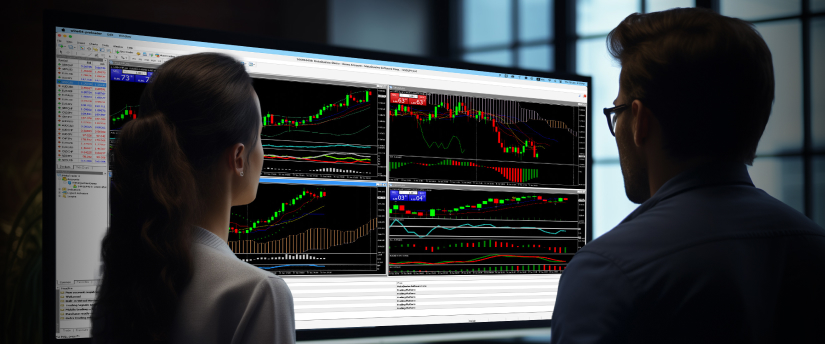In the history of forex trading, stories of rapid success are often too good to be true. But for some traders, especially those who began with modest goals, success became real. One story that stands out is that of Bill Lipschutz, who turned a side hustle into a multi-million dollar career.
Bill Lipschutz was born in 1956 in Farmingdale, New York. He did well in school and graduated from Cornell’s architecture program, also earning an MBA in finance from Cornell’s business school. Even though he had a passion for architecture, he couldn’t tolerate the length of time needed before he could work on real designs.
In school, Bill did hypothetical paper trading in a class where each student started with $100,000. By the end of the course, he had grown it to $29 million even though there were no limits on leverage.
شروع از کوچک
Bill Lipschutz didn’t plan to become one of the world’s top currency traders. While studying at Cornell University, he inherited $12,000 worth of stocks when his grandmother passed away.
The portfolio wasn’t simple, it included many different stocks, which were held in many different places. The effort of selling these stocks, along with his earlier success in paper trading, most likely motivated him to start trading with real money.
While at Cornell, he started trading using the $12,000 he inherited. He spent a lot of time researching the markets, which became a core part of his trading approach. Research came naturally to Bill. He finished his MBA in 1982, before the internet, so research meant long hours in the library. In comparison, today’s trading research is so much easier.

The big loss
Over four years at university, Bill turned his $12,000 inheritance into $250,000. He shares this story in the book The New Market Wizards: Conversations with America’s Top Traders. When asked what happened to this $250,000, Lipschutz refers to the “Granville reversal” in September 1982.
The advice of the famous market advisor Joe Granville to his readers went against his long position, and he lost nearly his entire account in less than a week when many people moved against him. Despite the loss, Bill didn’t lose confidence. He saw it as “one major mistake”, stayed focused, kept improving, and eventually secured a job at Salomon Brothers.
Joining the right broker
Bill’s next break came when he joined Salomon Brothers, one of the most prestigious investment banks at the time. This is where Bill really established his legacy. During his time at Salomon Brothers, he reportedly made the company $300 million in a single year from forex trading alone.
Salomon Brothers had an insular culture, known for developing its own traders and teaching them how to succeed. This approach applied to creating a foreign exchange department. While most companies would have hired a seasoned currency trader to lead such an effort, Salomon took a different route. They appointed a senior person from their bond arbitrage department to head the new FX department, even though he had no prior experience in FX.
This was a major opportunity for Lipschutz. It gave him the chance to make his mark in a newly established department focused on a market he already knew well. Bill was also the only person at Salomon with experience in options, an area that was just starting to become widely known in the trading world.
Lipschutz going independent
In 1990 Bill left Salomon Brothers, where his last position was head of the Global FX Options Group and the NY FX Trading Desk. As already mentioned, he reportedly generated over $300 million in most years for Salomon Brothers. After stepping away from trading for a short time, he returned to the markets in 1995 with his own firm, Hathersage Capital Management.
Bill Lipschutz’s trading strategy
The key focus of Lipschutz’s trading strategy is the management of the risk-reward ratio for each trade. He believes that the management of this aspect of trading can determine the success or failure of a trading system. In his opinion, the ideal risk-reward ratio is 3:1, which means that investors should focus on making $3 worth of profit for every $1 of risk. The core principles of his trading strategy include:
1. Trade judgement
Lipschutz emphasises the importance of evaluating the probabilities of success or failure before entering a trade. A high-reward trade with a high probability of loss is often worse than a low-risk trade with a high probability of profit. So, Lipschutz urges traders to focus on assessing the likely outcome of a trade set-up.
2. Position sizing
Lipschutz stresses that trade size is also a key part of any trading plan. It helps traders manage their risk and stick to their chosen risk-reward ratio. For example, if a trader has capital of $100,000 and a daily loss limit of $2,000, and they find a trading opportunity with a risk-reward of $1,000 risk to $3,000 reward per lot, they can enter into it with 2 lots and still stay within their risk limit.

3. Stop-loss and take-profit limits
A trader needs to set clear stop-loss and take-profit levels before entering a trade. This would help them stay disciplined and stick to their strategy, regardless of the trade’s outcome. These predefined limits also help traders avoid emotional decision-making, which is often where traders make costly mistakes.
Bill Lipschutz’s advice for beginners
Lipschutz is featured in several well-known trading books, including ‘The Mind of a Trader: Lessons in Trading Strategy from The World’s Leading Traders’ by Alpesh B. Patel and ‘The New Market Wizards: Conversations with America’s Top Traders’ by Jack D. Schwager. In these books, he shares valuable tips for those starting out in their trading journey, such as:
1. Never underestimate time as a risk factor
Bill Lipschutz advises “If most traders would learn to sit on their hands 50 percent of the time, they would make a lot more money.”
When you enter a new trade, it’s not just your money at risk, but also the time and attention that goes into monitoring it. So any trade with a longer time horizon carries greater opportunity costs, both in terms of the capital tied up and the attention it demands.
This makes it harder to manage multiple trades at once. So, a clear interpretation of this advice is to focus on one trade at a time and weigh all the costs related to it.
2. Absorb the pain that comes with the losses
According to Lipschutz, most traders experience beginner’s luck early on, but most give up when the losses start piling up. This is where most trading careers end. His advice to newcomers is to feel the pain of losses without letting it overwhelm you emotionally.
The reason for this is to avoid becoming numb to it. A mind that is numb to pain from financial losses tends to take bigger, reckless risks.

3. Never underestimate externalities
One of the biggest mistakes traders make is ignoring the million factors that can impact the outcome of a trade. External forces, like market sentiment and news events, can easily make or break a trading system.
That’s why it’s essential to account for these factors in your strategy. For example, a trader who relies on تحلیل بنیادی might still use تحلیل تکنیکال. It might not be their main technique, but there’s no harm in using it.
4. Make trading your passion
When trading becomes your passion, you devote more time and energy to learn the system that could improve your trading game.
5. Overconfidence is your biggest enemy
Lipschutz often reflects on his own journey – from rags to riches and back again – as proof that Forex trading has the potential to change your life in either direction.
The outcome depends entirely on your actions. He stresses that overconfidence is one of the most dangerous traits a trader can have as it can lead to reckless decisions. In contrast, consistent discipline forms the foundation for long-term success.
Disclaimer:
This information is not considered investment advice or an investment recommendation, but instead a marketing communication.
















